But finding the best food for giant dog breeds, doesn’t have to be a daunting task.
This guide is all you’ll need to make your choice.
Top food recommendations await below; but your ultimate pick will depend on:
- the form/type of food you’re feeding your giant breed
- a giant dog’s lifestyle, current weight, life stage, and overall health.
Though if you’re in a hurry, you can skip the line:
- Best for giant breed puppies: Holistic Select Natural Giant Puppy
- Best for adult giant dogs: Pro Plan Focus Adult Giant
- Best for senior giant dogs: Hill’s Science Diet Large Breeds
- Best grain-free option: Now Fresh Grain-Free Adult
- Best for stomach issues: CANIDAE PURE Dog Food
- Best for weight control: BLUE Life Protection Healthy Weight
- Best L.I.D for giant dog breeds: Nutrish Just 6 Natural LID Recipe
Narrowing down the individual needs of a giant dog:
- Is you giant breed an adult, still a puppy, or in their later years?
- Form of dog food they prefer: raw, wet, dry, canned, or a mixture?
- Does you dog have any dietary restrictions/needs: limited ingredient food, easy digestion, grain or gluten free, stomach sensitivity, weight control, etc?
Whoa! Did you think you’d be faced with such questions (and variety of paths) when buying your dog some good food? Luckily, this guide to feeding huge dog breeds is all you’ll need to navigate ashore.
If you’re not here purely for product recommendations, then you’ll enjoy learning more things about your dog, like: what defines a giant breed, their nutritional needs, general feeding tips for the different life stages, and finally our favorite choices from some trusted dog food brands.
What Is a Giant Dog? (Breed Examples)
Defining “giant dog breed”: Nearly everyone that sees a Newfoundland dog, a Tibetan Mastiff, or Zeus (the tallest giant dog ever), will have no trouble agreeing that they’re giant dogs. But what about the rest of the dogs we consider “giant?”
While it is true that companies and organizations may disagree as to the starting point (i.e. at what height, weight do large breed dogs cross over) for the “giant” classification; after such a point, however, they all consider these breeds “giants.”
Here’s the criteria we choose to adhere to when defining a giant dog:
Giant dog breed mass: You may see this differ across dog food labels, as companies use different criteria. But in this article, when we say ‘a giant breed,’ we mean: a dog whose standard average weight at maturity is over 100 lbs.
Giant dog breed height: Height is another determining characteristic debated among pet owners, food companies, and bloggers. However, in this article, when we say ‘a giant dog,’ we mean: a dog whose standard average height at maturity is over 26 inches.
Now: Read on to find out what you can do to help your dog live a happy & healthy life.
Nutritional Needs of Giant Breeds
Some of them may have been used as war dogs (like ancestors of the mastiff breeds) way back in the day, but nowadays these gentle giants lead much more peaceful lives. Looking after our families, and providing us with more joy (and scary moments!) than we can handle at times.
Here’s the deal: Out of all the breeds, giant dogs tend to have the shortest lifespans. Which makes the years we spend with them all the more special. It also means their growth, health issues, and dietary needs are different.
Here are some FAQs people encounter while raising giant breed dogs:
Important nutrients for giant breeds
These gentle giants of our lives are genetically predisposed to certain health issues, thus the last thing they need is an unbalanced diet and an unstable environment to make thing even worse.
Especially the giant breed’s puppy stage. It is the most crucial time to meet specific nutritional needs, ensuring proper physiological development and helping reduce/prevent long term health problems.
How can you help? Do your best to ensure your “giant-to-be puppy” is eating a premium dog food (preferably holistic, organic, or all-natural ingredients). Usually, a quality dog food formulated for giant breed puppies will contain the right balance of nutrients; with certain (but not every) “all life stages” foods also being qualified.
Basic nutrients to look for when feeding giant breed puppies:
- Calcium (1.2% – 1.5%)
- Protein (23% – 25%)
- Fat (12% – 15%)
Know this: Don’t feed your giant pup a high calorie diet! You want your puppy to grow tall and strong, but not too fast. Overly rapid growth comes with bone/joint problems. Aim for a moderate calorie range, about 350 -380 kcal/ cup. (Monitor your dogs activity and speak with a vet to confirm / set a more individualized range.)
Note: Don’t forget to count snacks and treat as part of your dogs daily calories!
What about nutrient needs of mature giant breeds: Great question! At this stage your dog needs higher levels of protein, calcium and fats. The six essential nutrients are water, proteins, carbohydrates, fats, vitamins, and minerals. But ideally you’d like to know how much of each, wouldn’t you agree?
The official nutritional guidelines developed by the Association of American Feed Control Officials are:

Credit: Association of American Feed Control Officials
The above is a general basis for nutrition requirements that commercial pet food companies should look to when formulating dog food.
How much food does my giant dog need?
Your first instinct is . . . a lot! Right?
You’re correct.
They do require more than their smaller cousins. But it’s not easy to generalize daily caloric needs of giant dogs; each dogs life is unique.
Optimal feeding levels vary depending on your pets temperament, age, health, breed, activity levels, and environment. Since you’re probably looking for something concrete, however, here’s an example giant dog breed feeding guide, based on weight and activity levels:
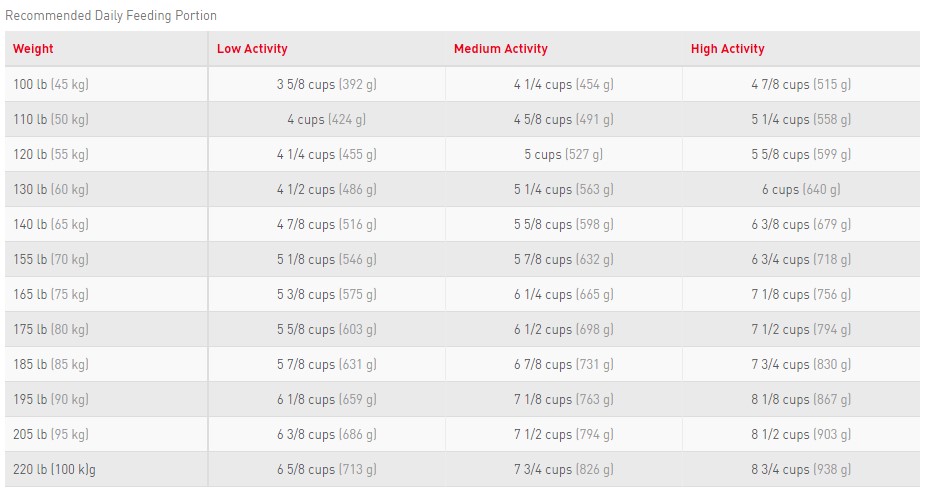
Credit: Royal Canin
Ideally, the right way to find out how much food your giant dog needs on a daily basis is to find your dogs ideal weight. Then proceed to feed according to that weight, adjusting as necessary. It can get pretty tedious without the help of your vet (with constant monitoring, and weighing giant dogs!).
But a brief consultation with your vet will yield a good estimation of daily calories you need to feed; based on your dogs lifestyle and body condition score. If you know your dog pretty well, you can also use the:
Standard formula for calculating caloric needs of an average adult dog, who:
- lives in the house
- gets light exercise on a daily basis
- is sprayed (or neutered)
Formula: ( 30 x Dog’s Weight in Kg ) + 70 = Daily Caloric Needs
How to convert kg to lbs: Simply take lbs and divide by 2.204. (So . . . 110 lbs / 2.204 = 49.90 kg)
Example: ( 30 x 49.90 (which is 110 lbs) ) + 70 = 1,567 calories per day.
Know this: Your dog is unique, and probably not “average.” So the above chart and formula is simply a good starting point for knowledge seeking owners. Most dogs will need fewer calories on a daily basis than the formula output; with few active dogs requiring more.
Important: The chart and formula is for adults, giant breed puppies have different and very important needs! (We discuss them in the feeding tips section below.)
How do I know if my giant breed puppy is growing too fast?
It’s true, puppies require a lot of food, and more often too! But at the same time, rapid growth is undesirable, and can be detrimental to their health. So how can you as a caring owner of a giant breed identify rapid growth!?
By using the body condition scoring tool to monitor your puppy’s body. Only feed your puppy the amount of food that will keep him lean: which translates to a 2 out of 5, (or a 4 out of 9, if a 1-9 scale is used) body condition score.
Here’s a body condition score chart for your reference using a scale of 1 to 5:

Help your giant breed dog live a longer, happier life by ensuring optimal giant breed puppy growth via knowing the following:
The myth: “Overfeeding will ensure my dog gets as big as possible.” No! Diet has an effect on how FAST your giant puppy grows, NOT how big they will be at maturity.
The dilemma: Skeletal problems caused by overfeeding giant puppies; during the active, rapid growth period just after weaning.
The solution: Controlled growth, NOT overgrowth. Your dogs ultimate size is pre-determined by their genes, so they’ll get there, don’t worry; but proper nutrition means they get there safely. Use your knowledge of your dog, and consult with your vet, to best adjust the feeding guidelines on the back of dog food labels accordingly.
Keep this in mind: Monitor your giant pups weight and physical activity continuously. Their appetites vary throughout their growing phase; so it is up to the owner’s to adjust the volumes and maintain a steady weight throughout.
Common Big Dog Health Problems
Whether you own a giant Pit Bull breed (most likely a Presa Canario mix), a Rottweiler, a Mastiff, a Barnese Mountain Dog, or some other giant breed; the common denominator is that giant dogs are at a higher risk for certain health problems than smaller dogs.
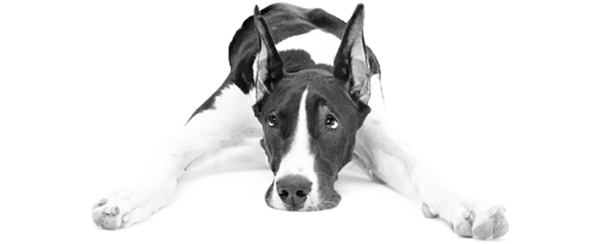
Most common health problems seen in giant dogs:
Please make sure you are in a position, both time wise and financially, to take care of a big dog should any of the below occur. These gentle giants rely on our nursing, in exchange for the joy and love they bring into our lives.
Orthopedic issues (less bone density means more problems)
- hip and elbow dysplasia (malformed or poorly fitting joints)
- cruciate ligament damage (typically “knee’ area of the back leg)
- panosteitis (inflammation of growing joints)
- hyperthrophic osteodystrophy (a.k.a HOD; swollen, painful joints)
- arthritis
- wobblers syndrome (most common in Great Danes and Doberman Pinschers)
Heart issues
- dilated cardiomyopathy (a.k.a DCM; heart muscles not contracting efficienlty -> irregular heartbeats)
- aortic stenosis (extra strain on the heart via narrowing of the aorta)
Eye issues
- entropion and ectropion (eyelash rolls inwards, irritating the cornea)
- cherry eye (gland in third eyelid inflames and enlarged)
Other issues
- hypothyroidism (low production levels of thyroxin hromone)
- bloat or torsion (a.k.a gastric dilatation volvulus; stomach fills suddenly with gas, twists unnaturally)
Certainly a lot to digest, isn’t it? The above is by no means an all encompassing list either. There’s just too many breed specific and overall variables to consider. Early detection and early treatment can play a pretty big role in the ultimate outcome.
So . . . you’re probably wondering what the best approach is to avoiding/reducing the above?
Formula for success (reducing your big dog’s health risks):
- Premium, quality giant breed dog food
- Adequate, appropriate exercise (not too much strain on bones/joints)
- Good lifetime veterinary care (vaccination, dental and annual checkups, etc.)
- Continuous, conscientious monitoring of weight and activity
Know this: Obesity carries with it a lot of health problems! Especially in extra large dog breeds with weaker bone density. Do your best to ensure your big dog is well fed but still maintains a healthy mass, and you’ll save a lot of money and heartaches.
Research findings: Studies have shown that contrary to what was once believed about skeletal issues, protein is not the culprit. Instead, the nutritional elements shown to adversely impact a giant puppy’s skeletal development are: excess calories and excessive/unbalanced mineral content (specifically calcium:phosphorus ratio).
Tips on Feeding Giant Dog Breeds
They say dogs grow up too fast. Well, when it comes to extra large dog breeds, this is an understatement! It also makes life-stage nutrition all the more important. Giant breed’s nutritional needs vary from when they are puppies to maturity.
Certain foods that are labeled “all-purpose” may actually not contain enough nutrients for puppies of a giant breed, pregnant giant breed dogs, or nursing mothers. On the flip side, they may offer too much of certain nutrients for the senior giant breed dog, and increase their risk of obesity.
Here’s the deal: Feeding your giant dog according to their life stage has been recommended by respected nutritionists. The ultimate goal being overall good health and well being, increasing both the quality and quantity of you giant dog’s life. Let us start from when they are born, shall we?
Giant breed puppy feeding (birth – 1.5/2yr): Instead of asking, “how big will my puppy get?” ask instead, “how can I keep my growing giant breed puppy lean, and optimally control their growth?“
The good news: Starting as of 2016, AAFCO guidelines now require dog foods categorized as growth to, ” . . . specify if they have met additional guidelines just for large- and giant-breed puppies.” Previously, some puppy stage dog foods were dangerously high in calcium for large and giant breed puppies.
Reduce risk of growth diseases by working together with a vet who knows giant breeds pretty well, and using this feeding chart for giant breed puppies as your starting point:
How to use this giant breed puppy feeding chart: These are general guidelines, to be used as a starting point in combination with your dogs individual dietary needs and requirements.
Assumption: Dog in question is crated, or less active during the day.
Females: Start with low-end amounts. Males: Use the mid-range figures.
Transitions: Don’t feed high-end amount until your dog is at least 1/2 way through to being a month older. Example: Female Great Dane at 17 weeks old, should be fed approx. 4 cups/day portioned into 2 daily meals; maximum 5 daily cups. Male Great Dane at 17 weeks old should be eating 5 cups/day; maximum 6 daily cups.
* Thanks to “The Great Dane Lady” (Linda Arndt, Canine Nutritional Consultant) on the above.
Know this: On a per body pound basis, puppies eat much more than adults. With younger puppies eating more than the older puppies. Raw fed giant breed puppies require a larger volume of food than their kibble-fed counterparts (as raw food has less fat and calories per ounce).
Giant breed adult feeding (2yr – 5yr): Overfeeding your adult giant can lead to obesity, which in turn leads to serious health conditions (like heart disease, and diabetes). Thus, avoid obesity at all cost.
We discussed earlier in this article, how much food your adult giant dog needs by providing a feeding chart.
Now: Let’s add on to the suggested volume and frequency of food based on weight and activity levels, with some additional feeding tips for an adult giant breed.
Practice controlled eating: Feed exact amount of food every day, based on weight and nutritional needs. Don’t leave food out all day; they are bored, and they will eat it!
Adjust for seasons: Is your giant dog more active in the summer than winter? Maybe walks and jogs are way more frequent during warmer months. But not just that, keeping warm and/or cool require extra energy expenditure. Adjust for this variation in energy needs accordingly.
Treat occasionally, not too often: Feed them healthy, low calorie treats, that should only make up less than 10% of their total daily calories consumed.
Free-choice feeding: This means leaving the food out (typically dry food that doesn’t spoil easily) for the dog to eat at their convenience. Typically, this method is used for pregnant giant breed dogs, as the mother-to-be has to eat more than usual. This method is not recommended otherwise, as it can lead to obesity.
Know this: If your giant dog is going through a recovery phase, whether due to surgery or a disease, they may require additional nutrition to help repair and heal (but also to fight off infection). Consult with your veterinarian if you find yourself in this situation.
Senior giant breed feeding (5yr+): The golden years is when your big dog needs you the most. Out of all the breeds, they’re considered seniors the earliest. With visible aging come some noticeable immunologic, metabolic, and body composition changes as well.
The ultimate goal: Maintain optimum body weight and overall health; slow down the development of chronic diseases and minimize diseases which are already present.
Don’t decrease protein intake: Ensure maintenance of good muscle mass by feeding your giant senior food that contains optimum levels of protein. Studies have shown that as they age, protein needs don’t decrease. Decrease the calories to ward off obesity, but maintain normal protein levels.
Speak with your vet about GLA and FOS: Gamma-linolenic acid (GLA) and Fructooligosaccharides (FOS). GLA, an omega-6 fatty acid normally produced in a dogs liver, plays a key role in skin and coat maintenance; it can diminish as the dog ages. FOS promotes the growth of beneficial bacteria, helping fight off disease.
Choose food containing vitamin E and beta-carotene: These helpful antioxidants destroy free-radicals (particles capable of body tissue damage, bring about signs of aging). They can also help with your senior giant’s immune system by increasing it’s effectiveness.
Know this: Before making any drastic changes to your older dogs diet, lifestyle, feeding habits, etc. Speak with your vet! Abrupt changes and stressful situations can throw you senior giant dog into a frenzy (exacerbating issues that would have otherwise happened gradually or not at all).
Best Food For Giant Dog Breeds (2018 Recommended Brands)
Learning about their nutritional needs above was fun, but this is what you’re really here for right!? You’ve got a BIG, hungry dog, that needs to be fed!
You might be wondering: Why don’t I see a lot of food specifically for extra large dog breeds? Currently (according to Chewy, the biggest retailer) there’s about 160 items under the giant breed category out there. But: Not all of them are exclusively for giant breeds, but instead a combo for large/giant dogs.
Until more pet food companies collaborate with knowledgeable nutritionists on formulating more giant breed specific dog foods, you are bound to see the large and giant classes coupled together. Though this is not too frowned upon by vets and experts, as long as the company meets the standard nutritional levels set by AAFCO.
But here’s the kicker: The coupling of dog food into “large/giant” puts more responsibility on you the owner. As, for example, a Pit Bull and a Great Dane will normally mature to two very different weights. Thus, it is up to caring giant dog owners to ensure proper volumes and that the food they’re buying contains the right nutrients, such as: protein, fat, calcium, glucosamine, and chondroitin.
What do the experts say: AAFCO currently provides no specific regulations or guidelines tailored for adult and senior giant dog breeds. But when it comes to giant breed puppies, however, they have issued a requirement: companies must state whether their foods labeled “growth/all-life stages” are acceptable (to ensure they’re not getting too much calcium) for puppies that will reach 70+ lbs at maturity. So we’re heading in the right direction!
Now: Here are some of our favorite food choices from some of the best dog food brands around, for various needs.
What’s the Best Giant Breed Puppy Food?
Have a puppy on his way to giant-hood? Proper nutrition during his early days will ensure the worries of the later years are minimized. First, ensure the puppy food contains the following statement:

Credit: AAFCO.org
Else the packaging will say something along the lines of, “except for growth of large-sized dogs (70 lbs or more as an adult).” Tip: That is your sign to not buy that food for your giant-to-be pup!
Otherwise, remember this: Controlled, optimal growth; NOT forced growth! Not too much calcium (not too little either). Measure and portion out meals throughout the day, avoid free-feeding to prevent nutrient excesses and obesity.
Now: You’re ready for a good food recommendation for giant breed puppies, here’s one of our favorites!
Our Top Pick: Holistic Select – Natural Giant Breed Puppy Food
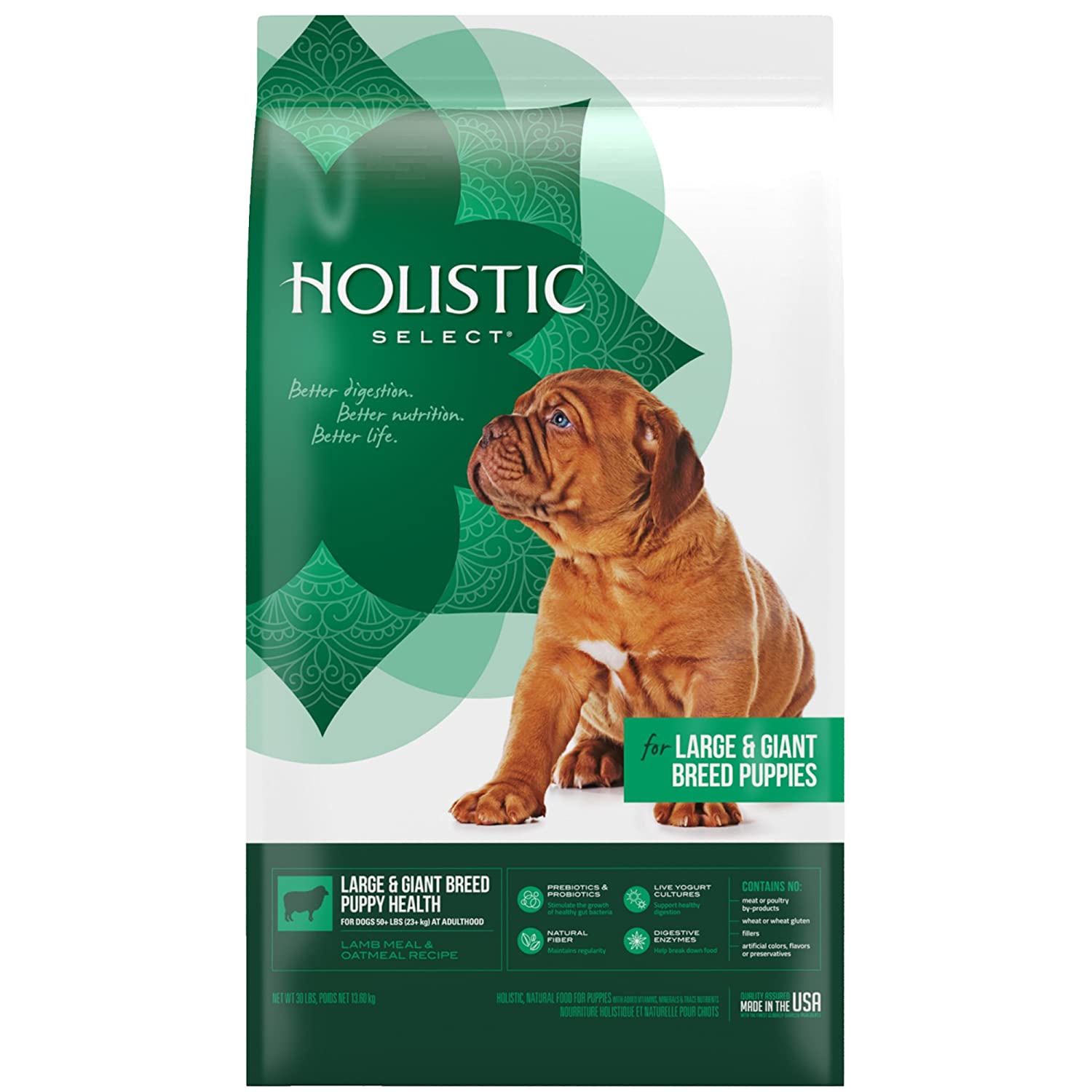
Notable ingredients: Lamb meal, chicken meal, oatmeal, brown rice, barley, peas, salmon oil, flaxseed, pumpkin, cranberries, digestive enzymes.
Flavors: Lamb & oatmeal. Packaging: 15 lb, 30 lb.
Value: $1.99/lb
Why we like it: First and foremost it is formulated to meet the unique growth nutrition levels set by AAFCO for giant breed puppies. This tasty formula contains within it the optimal levels of protein and fat for your giant pup’s muscle development and growth, as well as DHA from salmon oil to support healthy eye and brain development.
Also inside you’ll find prebiotics, probiotics, natural fiber, live yogurt cultures, and digestive enzymes for a healthy gut, all of which in turn means key nutrients are properly broken down and absorbed. Aside from superior digestion, on the nutrition side the formula contains nourishing fruits and veggies, antioxidant rich superfoods and natural ingredients. An overall premium ingredient, nutritionally balanced, all natural giant breed puppy formula. Backed by a “holistic select guarantee” and proudly made exclusively in the USA.
What’s the Best Food for an Adult Giant Breed Dog?
Well, they’re officially in their prime. Ready to eat anything and everything in sight; but not so fast! Though they may look quite imposing, they may not be done growing just yet. So . . . before switching you puppy to adult giant breed food, consult with your vet or a breed expert as to when it would be the best time to switch your particular breed to adult food. Just to play it safe!
Know this: Bigger dogs have slower metabolisms.
Big vs. small: The above is why you’ll see extra large dog breeds food containing fewer calories than other foods (especially small-breed options). Paradoxically, these gentle giants only require about 20 kcal/lb per day, whereas tiny toy breed require 40 kcal/lb per day. Not only that, they’re bones are more fragile too! So obesity should be kept at bay.
Now: You’re well informed to choose a quality adult giant dog food. Here’s a good option.
Our Top Pick: Pro Plan Focus – Dog Food for Adult Giant Breed
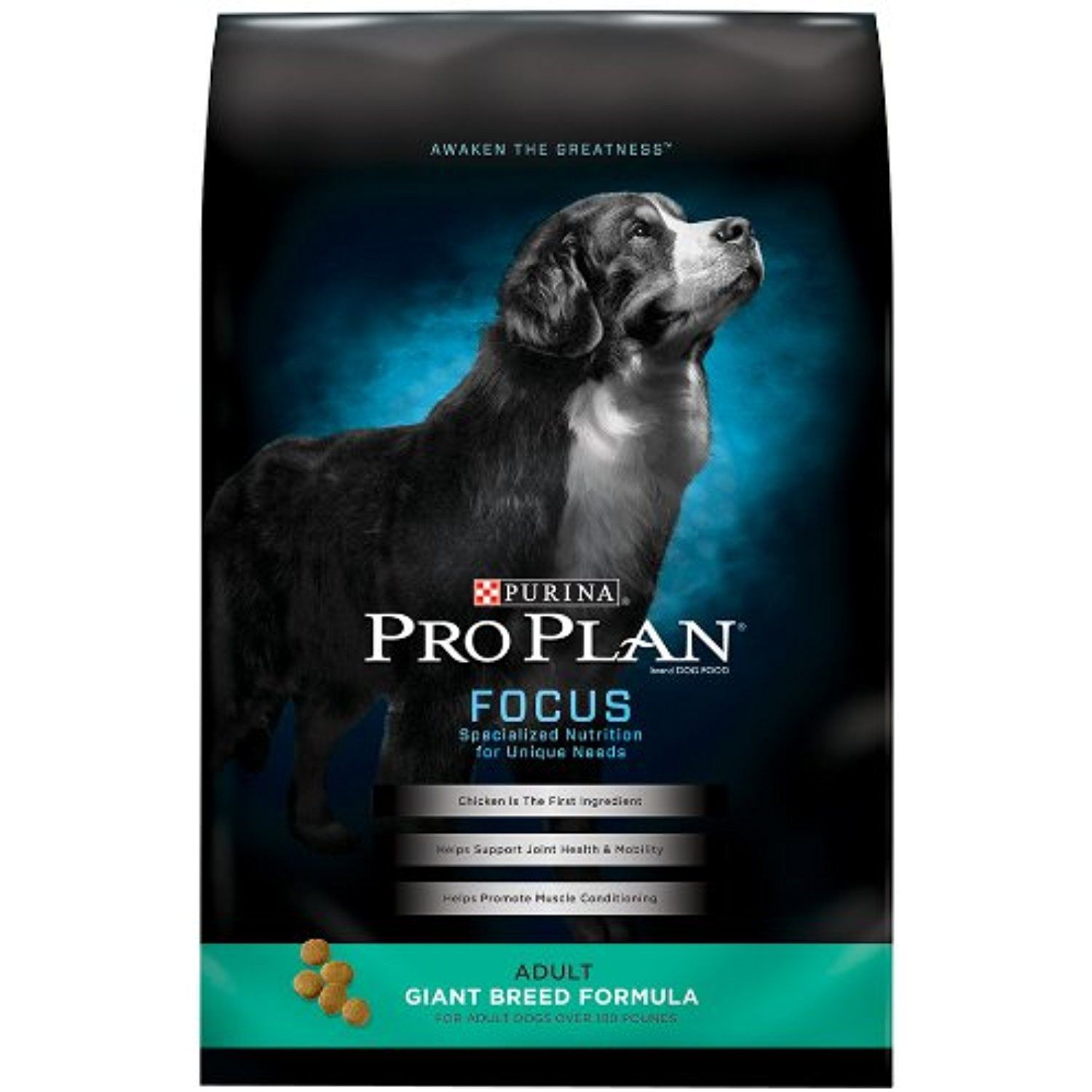
Notable ingredients: Chicken, brewers rice, corn gluten meal, oat meal, whole grain wheat, poultry by-product meal (natural source of glucosamine), pea fiber, fish meal, dried egg product, fish oil.
Flavors: Chicken. Packaging: 34 lb.
Value: $1.26/lb
Calorie Content (calculated): ME 1,718 kcal/lb; 3,787 kcal/kg; 383 kcal/cup.
Why we like it: Taking on the challenge of formulating a quality dog food for extra large dogs, Purina’s Pro Plan is getting the job done! Manufactured with high-quality ingredients (real chicken being the first protein providing ingredient), it looks out for your pets mobility and joint health with eicosapentaenoic acid (a.ka. EPA, an omega-3 fatty acid), and glucosamine. Furthermore the 26% protein and 12 % fat helps owners maintain ideal body weight; and finally this formula helps adult giant dogs with digestion using a natural prebiotic fiber sourced from wheat bran.
Backed by science: Feeding tests on live animals using AAFCO procedures validate that Pro Plan Focus Adult Giant Breed Formula provides complete and balanced nutrition for maintenance of adult dogs.
What’s the Best Food for the Senior Giant Breed Dog?
How is senior dog food any different: Dog food formulated for the aging canine will typically have higher levels of key minerals and vitamins; to help maintain and promote good health through old age.
How to take care of your giant senior dog: Here are some tips to consider when taking care of your beloved aging dog.
Vet who knows giant breeds: An invaluable resource, a knowledgeable vet is worth their weight in gold! They’ll tell you why your dog likes certain food, help you choose the food, when to switch your furry giant over to senior food, save you crucial time and headaches.
Here come joint issues: Health issues involving joints are basically all but a guarantee with extra large dog breeds. Thus, to help promote good health of your dogs aging joints, choose food high in omega fatty acids, glucosamine, and chondroitin.
Hold the calories, please: Weight gain in giant breeds is a recipe for disaster. Their fragile joints and bones just can’t handle the excess weight over time. Weight management is key.
Now: You’re informed and in a good position for a quality senior giant dog food recommendation.
Our Top Pick: Hill’s Science Diet – Veterinarian Recommended Dog Food

Notable ingredients: Chicken mean, brown rice, whole grain wheat, whole grain corn, whole grain sorghum, cracked pearled barley, pork fat, dried beet pulp; natural glucosamine and chondroitin.
Flavors: Chicken meal, rice & barley. Packaging: 17.5 lb, 33 lb.
Value: $1.77/lb (17.5 lb bag).
Why we like it: Senior big dogs need all the help they can get when it comes to bones and joints. In support of that, this science backed senior dog formula, offers natural sources of glucosamine and chondroitin. On top of promoting mobility and joint health, it contains a clinically proven blend of antioxidants with Vitamin E and C to help support immune system health. For a noticeable difference, this expertly formulated dog food for aging canines contains vitamins, fatty acids, and other key nutrients responsible for a healthy skin and coat.
The verdict is in: Precisely balanced nutrition + high quality ingredients + being #1 choice of vets (based on annual survey) = one big happy and healthy senior dog!
Best Grain-Free Giant Breed Dog Food
If your giant breed dog is on a grain free diet, here’s one of our favorite food options.
Our Top Pick: Now Fresh – Grain Free Dog Food (Adult)
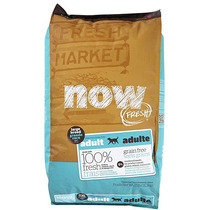
Notable ingredients: 100% fresh turkey, salmon, duck & 100% fresh Omega 3 & 6 oils from coconuts & canola. as well as calcium & phosphorus.
Flavors: Turkey, salmon, duck. Packaging: 12 lb, 25 lb.
Value: $3.39/lb.
Why we like it: An overall high quality fully grain free dog food your giant breed will love. The recipe features ZERO grains, wheat, beef, gluten, corn, or soy. No rendered meats, artificial preservatives, or by-products either! A great nutrient rich choice for active dogs, with New Zealand sourced green muscles, glucosamine and chondroitin to promote hip and joint health. Digestion wise you’ll find the formula contains pre and probiotics to help you giant dog absorb key nutrients; as well as added taurine for vision and heart function support.
Related: These Are the 6 Best Grain-Free Dog Food Brands
Best Food For Giant Dogs with Sensitive Stomachs
Ideal for: Giant sized dogs experiencing some food attributable tummy problems.
Sensitive stomach symptoms: Vomiting, diarrhea, and gas are the most common indicators.
Tip: Be sure to rule out bloat (a.k.a gastric dilatation-volvulus; a dangerous stomach conditions common with big dogs).
Spoke with your vet? Ruled out bloat or other issues? Great! Below is an option to consider for giant dogs with troubles metabolizing certain ingredients commonly found in dog foods, or just going through a phase.
Our Top Pick: CANIDAE PURE Dog Food – Simple Recipe fro Sensitive Dogs
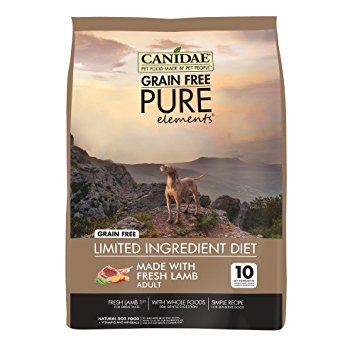
Notable ingredients (fresh lamb recipe): Lamb, sweet potatoes, chickpeas, peas, potatoes, chicken fat, suncured alfalfa.
Flavors: Fresh Bison, Fresh Chicken, Fresh Duck, Fresh Lamb, Fresh Salmon, Fresh Wild Boar. Packaging: 4 lb, 12 lb, 24 lb.
Value: $2.37/lb (24 lb bag)
Why we like it: Is your giant dog moping around with his head down, or is he in too much pain to move and just lays there with those big round eyes? Canidae has produced just the thing for their food related tummy troubles, a simple recipe for sensitive dogs. Less ingredients means less of a chance for sensitive reactions. It also means working with the flavors to identify which one is the problem. It still tastes great, contains fresh meat, has whole foods for gentle digestion, and provides essential nutrients. Run it by your vet, it might be just what your big dog is in need of.
Best Weight Control Dog Food for Giant Breeds
Ideal for: Overweight big dogs. Informed giant breed owners, aware of the detriments of obesity in giant dogs.
We covered many of the common health problems found in giant dog breeds earlier in this article; you should know that obesity exacerbates many of them and carries with it additional ones we didn’t include on the list.
Our Top Pick: BLUE Life Protection Formula – Healthy Weight Dog Food

Notable ingredients: Deboned chicken, brown rice, barley, oatmeal, chicken meal, dried tomato pomace, rice bran, peas, flaxseed, natural flavor.
Flavors: Chicken & brown rice. Packaging: 6 lb, 15 lb, 30 lb.
Value: $1.53/lb
Caloric content: 1,483 (kcal/lb) | 3,271 (kcal/kg) | 322 (kcal/cup)
Why we like it: We’ve more than stressed how important it is to prevent obesity in your giant breed dog. Now we present a viable solution for you to consider. The healthy weight life protection formula from Blue Buffalo provides your dog with premium dog food ingredients, essential nutrients, in the form of fewer calories from fat.
Among the stated weight control benefits your giant dog will appreciate, also comes promotion of: lean muscle development, strong bones & teeth, joint health, skin & coat health, and the immune system. Keep fat at bay by making sure your dog is active and eating a nutritious but lower on calories side food.
Best Limited Ingredient Food for Giant Sized Dogs
Ideal for: Giant dogs with food sensitivities and/or food allegries. Owners who are working with their vet to identify the culprit ingredient and remove it from their pets diet.
Does your giant breed need an LID diet: If you, or in combination with your vet, have discovered/determined your dog is certainly experiencing reactions to certain ingredients, than an limited ingredient giant breed dog food may be the solution. Experimenting with different flavor (thus ingredients) will help illuminate the sensitivity.
Now: You’ve determined your big dog needs LID food? Here’s one of our top choices to consider.
Our Top Pick: Rachael Ray Nutrish – Just 6 Natural LID Recipe

Notable ingredients: lamb meal, ground rice, brown rice, dried plain beet pulp, chicken fat, natural pork flavor, zinc proteinate, sodium & potassium chloride, dicalcium phosphate.
Flavors: Lamb meal & brown rice. Packaging: 6 lb, 14 lb, 28 lb.
Value: $2.29/lb
Why we like it: You probably know Rachel Ray is a master chef when it comes to human food, but she’s also made quite the name for herself by formulating dog food recipes. This limited ingredient giant breed dog food has, as the name suggests, just 6 simple ingredients; and vitamins & minerals added in for wholesomeness. If the giant in your life is having reactions to other foods, and is looking to try something on the simpler side, this might be the natural ingredient product for them. Aside from the nutrition aspect, a portion of each sale goes to The Rachel Ray foundation, an organization that helps animals in need (of food, medical supplies, treatments, etc.).
Best Dry Dog Food for Giant Breeds
Below is a quality dry food option for huge (pronounced yuuuuuge!) dog breeds.
Our Top Pick: Holistic Select – Natural Dry Dog Food

Notable ingredients: Chicken meal, ground brown rice, ground white rice, oatmeal, chicken fat, anchovy & sardine meal, dried egg product, flaxseed, tomato pomace, carrots, sun-cured alfalfa.
Flavors: Chicken & oatmeal. Packaging: 15 lb, 30 lb.
Value: $1.88/lb
Why we like it: It contains the optimal levels of calcium and phosphorus your giant breed needs for bone health maintenance. Along the same lines, it’s formulated with glucosamine hydrochloride and chondroitin sulfate to support the health of your big dogs hips and joints. Large dry kibble, made with premium all natural ingredients developed using a unique digestive health support system (focused around live yogurt cultures, pre & probiotics, natural fibers) for sustained energy. No meat by-products, no wheat, no wheat-gluten, or artificial flavors, colors, or fillings.
Best Wet Dog Food for Giant Breeds
Below is a super palatable (pronounced dee-lee-cious!) and nutritious wet dog food recommendation for giant dogs.
Our Top Pick: Solid Gold Holistic Dog Food
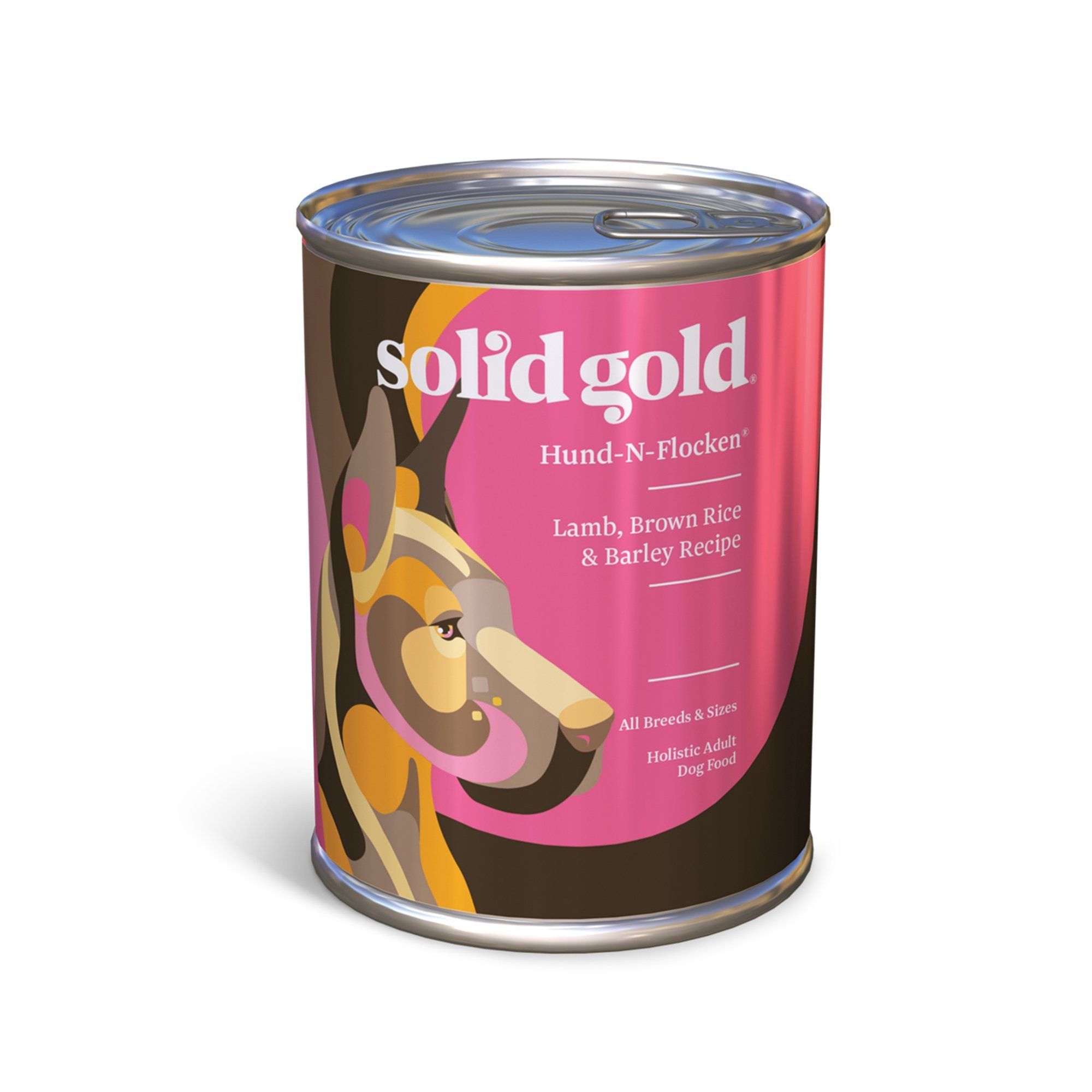
Notable ingredients: Lamb, water sufficient for processing, carrots, guar gum, brown rice, lamb liver, barley, potassium chloride, oatmeal, olive oil.
Flavors: Lamb, brown rice & barley. Size: 13.2 oz. (1 can)
Value: $2.50/can
Why we like it: Aside from the fancy looking design? Aside from the fact it can be served as a tasty standalone whole meal and as a food topper? Let’s see: tender and delicious holistic New Zealand lamb recipe, optimal balance of hearty grains and high-density protein created to support your giant breeds healthy mind, body, and (big) spirit! If your giant friend loves wet dog food, this is a good nutritionally complete and balanced option.
Guaranteed analysis: Crude protein (8.5% min.), crude fat (8.5% min.), crude fiber (1.5% max.), moisture (78.0% max.).
Best Raw Dog Food for Giant Breeds
Please note: If your’re attempting/considering to feed your giant breed a completely raw diet, make sure you develop a VERY solid understanding of dog nutrition principles. Calculating the right nutrient ratios and ensuring essential levels are met via strictly raw food requires a significant nutritional background.
Is your giant on a BARF (biologically appropriate raw foods) diet? Here’s a raw food diet friendly food choice to consider.
Our Top Pick: Only Natural Pet – EasyRaw Dehydrated Raw Dog Food Formula
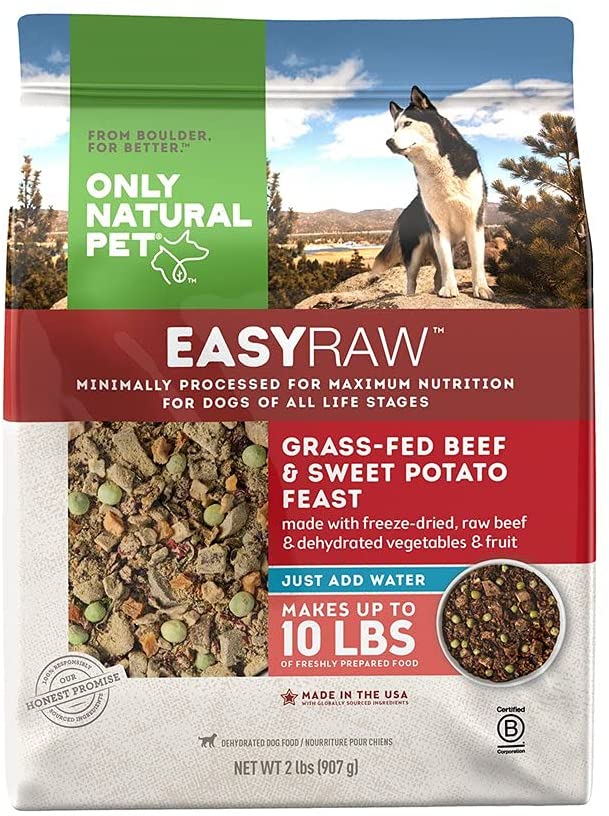
Notable ingredients (beef & sweet potato recipe): Grass fed beef, sweet potato, carrots, whole egg, broccoli, cranberries, celery, yellow split pea.
Flavors: Beef & sweet potato, chicken & oats, turkey & sweet potato, lamb & sweet potato. Packaging: 2 lb bag (makes 12 lbs of food), 7 lb bag (makes 40 lbs of food).
Value: $12.42/lb (for the 7 lb bag)
Caloric content (ME calculated, as fed): 1,681 kcal/lb; 3,707 kcal/kg; 363 kcal per cup
Why we like it: In contrast to conventional kibble, which is cooked at very high temperatures, this formula contains freeze dried raw meat (that’s never cooked), along with dehydrate fruits and veggies (gently heated to 115 degrees for optimal nutritional value). Essentially, your giant dog breed will receive a high quality diet with significantly less processing and absolutely none of: artificial flavoring, coloring, fillers, or preservatives.
The packaging may seem small (and pricey) but don’t be deceived. There is more value in the bag than meets the eye, that’s because by simply adding water, stirring and waiting about 15 minutes, you’ll transform 7 lbs into 40 lbs of dog food for your big dog to enjoy! Then sit back and watch as your dog chows down on this USA made small batch handcrafted (paleo friendly) holistic formula, enriched with high quality protein and farm fresh veggies!
Best Canned Dog Food For Giant Breed Dogs
This easy to store, long lasting dog food is a great choice for you giant friend. But don’t forget to remove it / dispose of it after they’re done eating, lest it spoils!
Dogs love it: Canned dog food has a reputation for being super tasty! Here’s one of our favorite picks.
Our Top Pick: Taste of the Wild – High Protein Natural Canned Stew Dog Food

Notable ingredients (fowl formula): Real duck, vitamins & minerals, fruits & veggies as superfoods, fatty acid blend, prebiotic fiber, sweet potatoes, blueberries and raspberries.
Flavors: Smoke salmon, wild boar, fowl. Size: 13.2 oz.
Value: $2.29/can
Why we like it: Whether you serve it as a standalone meal, or top your dogs dry food kibble with it, they will absolutely chow down this delicious formula! With it’s Chunky texture, palatable rich gravy, this all natural canned dog food provides your dog antioxidants and high protein count with every bite (sourced from only the highest quality meats, in this case real duck).
Supplemented with veggies and fruits to ensure essential nutrients are delivered; plus sweet potatoes and peas for digestion support, which in turn provides you giant with sustained energy to lead happy lives. This canned food grain free and gluten free, with no corn, and no soy. Made by a family owned USA company (with scientifically advanced food safety protocols), sources ingredients from trusted and sustainable sources across the globe. Yummy, indeed!
Best Affordable Dog Food For Giant Dogs
Ideal for: Owners of bigger dogs who are on a quest for budget friendly giant breed food.
Value feeding your giant breed: The cost of dog food adds up fast doesn’t it? But it’s not just the traditional food, it’s the treats, the vet trips, the toys, and so on. The good news is that, your extra big dog can still get the daily nutrients they need, at a reasonable price. There’s a market for everything, as they say. This is true with good dog food on the cheaper side as well. Here’s one in particular to consider.
Our Top Pick: Purina Dog Chow Complete Made with Real Beef
Notable ingredients: Whole grain corn, poultry by-product meal, corn gluten meal, naturally preserved beef fat with mixed-tocopherols, beef, ground rice, soybean meal, meat and bone meal.
Flavors: Beef. Packaging: 20 lb, 36 lb, 46 lb, 52 lb.
Value: $.69/lb
Why we like it: It allows you to keep paying the mortgage and feed your giant dog a balanced diet simultaneously. All jokes aside, this USA crafted, complete adult dog food formula comes 100% complete and balanced: with real beef, 23 different minerals & vitamins, supports your dogs immunity and skin/coat. An overall wholesome meal option for your giant breed that won’t break the piggy bank.
Conclusion
We know, we know, this article was bigger than your dog! But hey, there’s a lot to cover when it comes to these furry giants in our lives. Hopefully you’re a more informed pet owner after reading the above.
You’re also now more aware of just what a huge responsibility being a pet owner and raising a giant breed dog can be. We leave you with the diverse selection of the top giant breed dog foods above to consider when hunting down the right one for you and your pet, and wish you a happy, healthy journey together!

